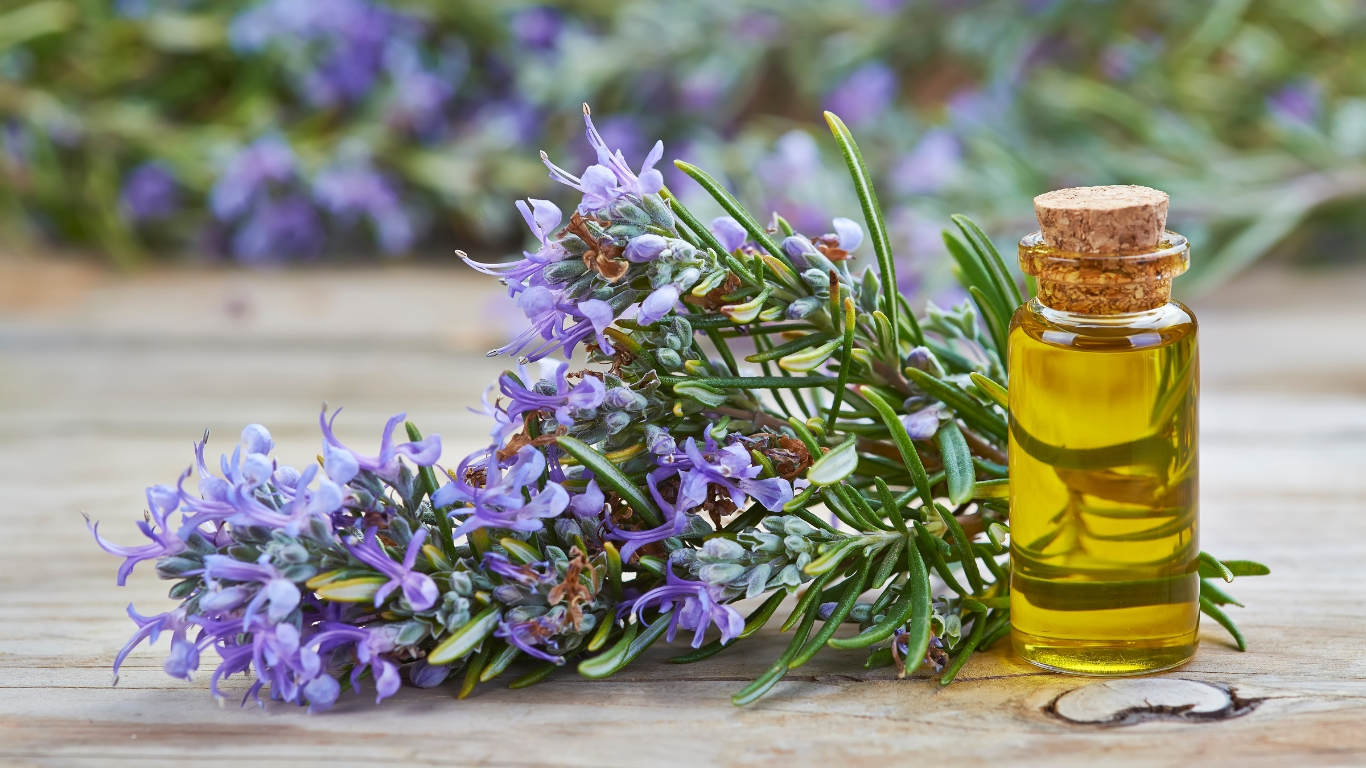
Introduction
Rosemary (Rosmarinus officinalis) is a perennial herb known for its aromatic fragrance and wide array of uses, ranging from culinary applications to therapeutic benefits. Extracted from the leaves and flowering tops of the plant, rosemary essential oil is a potent, versatile oil celebrated for its numerous health benefits. This article delves into the history, extraction methods, chemical composition, therapeutic uses, and precautions associated with rosemary oil, providing a comprehensive understanding of its value.
Historical Context and Cultural Significance of Rosemary Oil
Ancient Origins
The use of rosemary dates back to ancient civilizations. The Egyptians, Greeks, and Romans highly valued rosemary for its medicinal properties and its role in religious rituals. It was often burned as incense in sacred ceremonies and used in burial rites to symbolize remembrance.
Medieval and Renaissance Periods
In medieval Europe, rosemary was considered a protective herb, believed to ward off evil spirits and plague. It was commonly used in traditional medicine to treat a variety of ailments, including digestive issues, respiratory conditions, and skin problems. During the Renaissance, rosemary’s reputation grew, and it became a symbol of fidelity and love, often incorporated into wedding ceremonies and decorations.
Extraction Methods of Rosemary Oil
Rosemary essential oil is primarily extracted through steam distillation, a process that involves the following steps:
- Harvesting: Fresh rosemary leaves and flowering tops are harvested.
- Distillation: The plant material is placed in a distillation unit where steam passes through it, causing the essential oils to evaporate.
- Condensation: The steam carrying the essential oils is cooled and condensed into a liquid.
- Separation: The essential oil is separated from the water, resulting in pure rosemary oil.
Alternative methods, such as solvent extraction and cold pressing, can also be used, but steam distillation is the most common due to its efficiency in preserving the oil’s therapeutic properties.
Rosemary Oil Chemical Composition
Rosemary oil is composed of a variety of bioactive compounds, each contributing to its therapeutic effects. The primary constituents include:
- 1,8-Cineole (Eucalyptol): Known for its anti-inflammatory, analgesic, and respiratory benefits.
- α-Pinene: Exhibits anti-inflammatory, bronchodilator, and antimicrobial properties.
- Camphor: Provides analgesic, anti-inflammatory, and antispasmodic effects.
- Verbenone: Known for its skin-healing and regenerative properties.
- Bornyl Acetate: Contributes to the oil’s calming and anti-inflammatory effects.
These compounds work synergistically to deliver rosemary oil’s wide-ranging benefits.
What is rosemary oil good for?
Hair and Scalp Health
One of the most well-known uses of rosemary oil is for promoting hair growth and maintaining scalp health. The oil’s ability to improve blood circulation ensures that hair follicles receive essential nutrients and oxygen, stimulating growth and strengthening hair. Regular application can help prevent dandruff, reduce scalp irritation, and enhance overall hair quality.
Application Methods:
- Scalp Massage: Mix a few drops of rosemary oil with a carrier oil (such as coconut or jojoba oil) and massage into the scalp.
- Hair Rinse: Add rosemary oil to a final rinse after shampooing to improve shine and manageability.
- Hair Mask: Combine rosemary oil with other nourishing ingredients like honey and yogurt for a deep conditioning treatment.
Skin Care

Rosemary oil’s antimicrobial and anti-inflammatory properties make it a valuable addition to skincare routines. It can help treat acne, reduce skin irritation, and promote a clearer, more radiant complexion. Its antioxidant properties also help combat signs of aging by neutralizing free radicals.
Application Methods:
- Facial Steam: Add a few drops of rosemary oil to a bowl of hot water and use as a facial steam to open pores and purify the skin.
- Topical Application: Dilute rosemary oil with a carrier oil and apply to affected areas to treat acne or other skin conditions.
- Moisturizer: Incorporate rosemary oil into your daily moisturizer for added anti-aging benefits.
Can you apply rosemary oil directly to skin?
Applying rosemary oil directly to the skin without dilution is generally not recommended due to its high concentration and potent nature, which can cause skin irritation, burns, or allergic reactions. Essential oils, including rosemary oil, contain powerful active compounds that can be too harsh when applied undiluted.
Cognitive and Mental Health
Rosemary oil has been traditionally used to enhance cognitive function and improve memory. Its stimulating properties can help increase alertness, concentration, and mental clarity. Additionally, rosemary oil’s calming effects can help reduce stress and anxiety.
Application Methods:
- Aromatherapy: Diffuse rosemary oil in a diffuser to inhale its uplifting aroma.
- Inhalation: Add a few drops of rosemary oil to a handkerchief and inhale deeply for a quick mental boost.
- Massage: Blend rosemary oil with a carrier oil and use for a relaxing and invigorating massage.
Pain Relief and Muscle Tension
Rosemary oil’s analgesic and anti-inflammatory properties make it effective in relieving pain and reducing muscle tension. It can be used to treat headaches, muscle aches, joint pain, and even conditions like arthritis.
Application Methods:
- Topical Application: Dilute rosemary oil with a carrier oil and apply to affected areas to relieve pain and reduce inflammation.
- Bath: Add a few drops of rosemary oil to a warm bath for a soothing and pain-relieving soak.
- Compress: Create a warm compress with rosemary oil to apply directly to sore muscles or joints.
Respiratory Health
Rosemary oil can be beneficial for respiratory conditions such as colds, coughs, and bronchitis. Its expectorant properties help clear mucus and ease breathing.
Application Methods:
- Steam Inhalation: Add a few drops of rosemary oil to hot water and inhale the steam to relieve congestion.
- Chest Rub: Mix rosemary oil with a carrier oil and rub on the chest to help clear respiratory passages.
Precautions and Considerations
While rosemary oil offers numerous benefits, it is important to use it safely and responsibly. Here are some key precautions to consider:
Dilution
Rosemary oil is highly concentrated and should always be diluted with a carrier oil before topical application to prevent skin irritation. A typical dilution ratio is 2-5% rosemary oil to 95-98% carrier oil.
Allergies
Before using rosemary oil, perform a patch test to ensure you do not have an allergic reaction. Apply a small amount of diluted rosemary oil to a patch of skin and wait 24 hours to check for any adverse reactions.
Pregnancy and Nursing
Pregnant and nursing women should consult with a healthcare provider before using rosemary oil, as it may cause uterine contractions or affect hormone levels.
Epilepsy and High Blood Pressure
Individuals with epilepsy or high blood pressure should avoid using rosemary oil, as it may exacerbate these conditions.
Internal Use
Rosemary oil should not be ingested unless under the guidance of a qualified healthcare professional. Ingesting essential oils can be dangerous and lead to serious health issues.
Conclusion
Rosemary oil is a potent and versatile essential oil with a wide range of therapeutic applications. From promoting hair and skin health to enhancing cognitive function and relieving pain, its benefits are extensive. However, it is crucial to use rosemary oil safely by adhering to proper dilution guidelines and being mindful of potential contraindications. With its rich history and powerful properties, rosemary oil remains a valuable addition to natural health and wellness practices.
